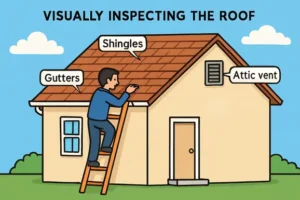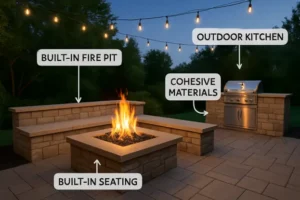There’s something undeniably charming about an old home—ornate woodwork, vintage fixtures, and architectural character that’s hard to replicate in modern construction. But with that charm comes responsibility. Older homes often require more TLC to stay safe, comfortable, and beautiful. The good news? Maintaining your old home doesn’t have to be overwhelming. With a clear plan and a few practical habits, you can keep your beloved home in great shape for years to come.
1. Understand Your Home’s Unique Needs
Every older home tells a story—and part of that story includes the materials, techniques, and systems that went into building it. Start by learning the age of your home and researching the common issues that homes from that era face. For instance, homes built before the 1970s may contain lead paint or outdated electrical systems, while those from the early 20th century might have knob-and-tube wiring or aging clay pipes.
Getting a comprehensive home inspection by someone experienced with older properties is a smart first step. They’ll help you understand the current state of your home and identify problem areas before they become costly repairs.
2. Prioritize Structural Integrity
The foundation and frame of your home are the backbone of its structure. Over time, settling, moisture, and general wear and tear can weaken these crucial elements. Look for cracks in walls, uneven floors, or doors that don’t close properly—these may be signs of foundation movement or structural stress.
Check your attic and crawl space for signs of rot, pests, or sagging beams. If you notice any issues, consult with a contractor or structural engineer. Fixing small problems early can prevent major repairs down the line.
3. Stay Ahead of Water Damage
Water is one of the biggest threats to old homes. Leaky roofs, clogged gutters, and poor drainage can all lead to costly damage. Inspect your roof annually for missing or curling shingles, and clear your gutters at least twice a year to keep water flowing away from your home.
Check for damp spots in basements or around windows, and ensure that your yard slopes away from the foundation. Installing a sump pump or French drain can help manage excess groundwater and protect your home’s lower levels.
4. Modernize With Care
Although the charm of a vintage home is hard to beat, certain upgrades are essential to ensure both safety and energy efficiency. For instance, older electrical systems may not be equipped to support today’s appliances and technology—upgrading your wiring and circuit panel is often a wise investment. In addition, if your home still has single-pane windows or aging insulation, it may be time for an update.
These features can significantly impact your home’s energy usage, especially in climates like Utah’s, where seasonal temperature swings are common. Consider window replacement in Utah to improve insulation and reduce heating and cooling costs while maintaining your home’s classic style. Fortunately, many modern materials offer excellent performance without compromising historic character, allowing you to enjoy the best of both worlds.
5. Keep an Eye on the Details
The little things matter in older homes. Wooden trim, plaster walls, and antique fixtures all add charm, but they need regular care to avoid deterioration. Repaint wooden surfaces every few years to prevent rot. Repair small cracks in plaster walls before they spread. Oil squeaky hinges and tighten loose door handles.
Routine maintenance of these features keeps your home looking polished and prevents small issues from growing into big ones.
To ensure your old home remains comfortable and energy-efficient, consider upgrading your HVAC system. Regular maintenance and timely upgrades can significantly enhance your home’s air quality and reduce energy costs. For expert assistance, Andersen Air Inc offers comprehensive HVAC services tailored to the unique needs of older homes. Their experienced technicians can help you choose the right system and provide ongoing maintenance to keep your home cozy year-round. By investing in professional HVAC care, you can preserve the charm of your old home while enjoying modern comfort and efficiency.
6. Create a Seasonal Maintenance Routine
Consistency is key to keeping any home in top condition, especially an older one. Break your maintenance tasks into seasonal checklists:
- Spring: Inspect the roof, clear gutters, check exterior paint, and prep your garden.
- Summer: Service HVAC systems, inspect plumbing, and test smoke/carbon monoxide detectors.
- Fall: Clean chimneys, seal windows and doors, and prepare pipes for cold weather.
- Winter: Monitor for drafts, check insulation, and stay on top of snow removal and ice dams.
Sticking to a routine makes upkeep feel more manageable and ensures nothing slips through the cracks.
7. Embrace Preventive Care
Preventive maintenance is always easier—and cheaper—than emergency repairs. Schedule regular service appointments for heating and cooling systems, keep an eye on humidity levels to prevent mold, and don’t ignore strange noises or smells. These are often early warning signs that something’s amiss.
A little attention today can save you from major headaches tomorrow.
Maintaining an old home can be a rewarding experience, but it also comes with its unique set of challenges. One common issue is water damage, which can compromise the structural integrity and charm of your beloved abode. Regular inspections and prompt repairs are crucial to preserving your home’s character. If you notice signs of water damage, it’s essential to address them immediately to prevent further deterioration. For expert assistance, don’t hesitate to get in touch with professionals who specialize in restoration services. They can provide the necessary expertise to restore your home to its former glory, ensuring it remains a cherished space for years to come.
8. Know When to Call in the Pros
While DIY can save money, some jobs are best left to professionals. Tasks like electrical rewiring, roof replacement, or foundation repair require specialized skills and tools. If you’re ever unsure, don’t hesitate to call in an expert. It’s a smart investment in your home’s future.
Final Thoughts
Loving your old home means more than just admiring its charm—it means caring for it with intention. By understanding its needs, staying proactive, and making thoughtful upgrades, you can enjoy the warmth and character of your vintage haven for generations to come. With a little know-how and a lot of heart, maintaining your old home truly becomes simple.
Also read-Designing a Home for a Large Family








